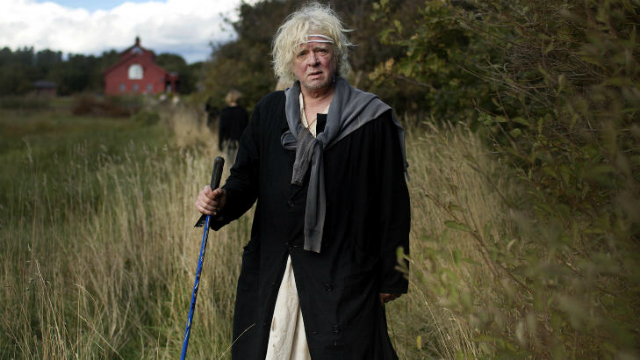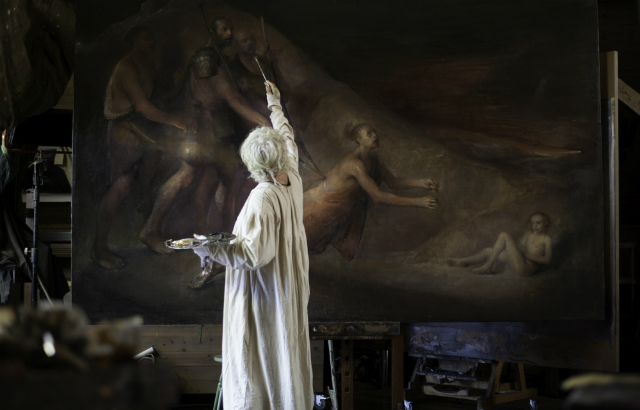
A portrait of Norwegian painter Odd Nerdrum. (Credit: Dagbladet)
Any art student might remember the adage “fat over lean” as a caveat about mixing mediums when building up surfaces. “Fat” refers to the gooey or translucent mediums used to bulk-up paint. “Lean” refers to the purer foundation of pigment a painting must be built upon. Many probably thought, “what’s the worst that could happen to a painting that fails to follow these rules, beyond mere cracking?” Apparently, jail time.
Less than three weeks before the April 30th opening of Odd Nerdrum’s show at Manhattan’s Booth Gallery, director and curator Casey Gleghorn received an email from one of Nerdrum’s sons announcing the unexpected. The 72 year old Norwegian painter, expected to fly in for his first American solo show in five years, could no longer attend the opening because he was going to jail to serve a one year sentence for tax fraud.
“There were all these rumours going around,” said Gleghorn in an interview with AFC, who considers Nerdrum to be “one of the biggest artists I have worked with.” Even though Gleghorn was loosely aware of what had been reported in the media, the director and curator “didn’t feel comfortable talking about it with [Nerdrum].”
As it stands, even though the painter was summoned by the Norwegian government to go to jail on April 18th — after his plea to serve the sentence at home due to health issues (he suffers from Tourette syndrome) was dismissed — the decision was postponed indefinitely. Nonetheless, the fact remains Nerdrum could be summoned to go to prison at any time.
“They can’t appeal it anymore. It’s gone through the court system as far as it can,” says David Molesky, a New York-based artist and former studio assistant of Nerdrum. “Now they’re in a real terrible way, with this hanging over head.”

Nerdrum’s “The Last Procedure”, one of the new oil on canvas works that will be showing at Booth Gallery. (Credit: Booth Gallery)
The case is complicated. In August 2011, Nerdrum was sentenced to two years in jail by the Oslo district court for tax evasion amounting to $2.6 million of his taxable income. Nordrum earned this money just prior to him becoming a citizen of Iceland. According to an email timeline provided by Molesky and Gleghorn, this was the result of Nerdrum’s attempt to fix works that had “melted” between 1989 and 2002 due to a failed attempt at mixing Maroger medium. (Nerdrum had received some bad advice from a Norwegian conservator.) Nerdrum was then charged property taxes by the authorities for both originals, despite having only written off the cost of the original and choosing to exchange or reimburse collectors on the melted originals. “The painting replacements were valued as the same value as the originals,” says Gleghorn. “Which is more messed up to me, because they were taxing on two different paintings.” (Gleghorn couldn’t confirm, however, if the originals were ever destroyed.)
“I paid 50% of the $2.5 million in 1998. And then I paid another 50% on that sum in 2002, adding up to 100% of the $2.5 million,” Nerdrum was quoted at the time by the Norwegian newspaper Dagbladet in confirming he had paid the taxes years ago. “Hasn’t the goal been reached by the Norwegian government yet?”
But this isn’t the only problem he’s had with the government. When Nerdrum joined Forum Gallery in 1997 after splitting from Marina Hamilton a few years before, Forum and Nerdrum negotiated to set aside a percentage of the sale as security against the melted paintings. These funds, which came from sales during 1998-2002, were held in an Austrian safety deposit box. artdaily.org reported the fund was established by the artist and American gallery as a “safety measure” against future claims by collectors who wanted to be compensated with money rather than receive a replacement. But according to an anonymous source close to the gallery, this safety measure coincided with the global economic crisis at the end of the 1990s. “[Odd] did not want all the money to be in the gallery,” tells the source.
Despite the story of the damaged paintings being well-known at the time, the court ruled that all the above was an elaborate cover-up and “the only reason for placing cash in a bank box in Austria was to avoid this income being taxed in Norway.”
“The main evidence against Nerdrum is that he and his accountant did not report this check held in mutually in trust as income,” wrote Gleghorn and Molesky in the timeline. “A notarized agreement between Odd and the gallery was offered as evidence (and ignored).”

“Odd Nerdrum In Front of Memerosa”, another new work from the Booth show. (Credit: Booth Gallery)
Nerdrum’s lawyer quickly appealed the August 2011 decision less than a year later, but the court of appeals increased his prison time to two years and ten months. The anonymous source acknowledges that two independent witnesses — Icelandic accountants — gave stories in support of Nerdrum’s case, but were teared down by the prosecution, and were accused of lying by the government. “The secondary court is always more corrupt,” explains the source. The harsher term, however, inspired Anders Fjellberg, a journalist with Dagbladet, to investigate the case further.
In 2013, thanks to new evidence uncovered by Fjellberg, the case was successfully appealed in Supreme Court. Fjellberg “proved that not only he paid his taxes, but paid more than he should,” says Gleghorn.
Despite this new evidence providing the artist had paid his taxes, Nerdrum was sentenced in June 2014 to one year in prison for tax fraud after the case had been appealed twice “because he had admitted to considering evading his taxes,” says Molesky.
Both Gleghorn and Molesky believe Nerdrum has been a target by the government because of his criticism regarding the country’s socialist art programs. “Norway has had a history of punishing creatives who have become very successful outside of their state system,” says Molesky. He compares Nerdrum’s treatment to Edvard Munch, another Norwegian painter who was similarly persecuted by the country’s tax authorities. “It was so traumatic he had to have electric shock therapy,” adds Gleghorn. “He made ten drawings about the whole thing, and they destroyed eight of them.”
Molesky and Gleghorn both exclusively confirm with AFC that Nerdrum’s family will not publicly campaign against the verdict for fear it will hasten Nerdrum serving of his prison time. They are also exhausted by a five year-long legal battle that despite being appealed twice, has ended with a harsh sentence for a tax fraud case that has been recognized for its weak incriminating evidence. “This is a very traumatic and painful and upsetting experience and they don’t want to relive it going through the details again,” says Molesky.


Comments on this entry are closed.